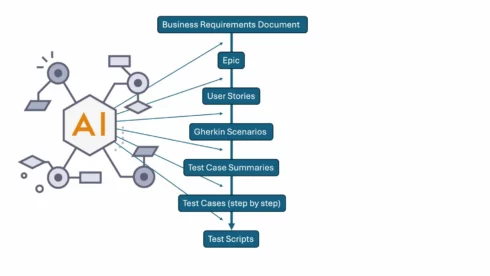
For decades, software testing has been built on a simple idea: humans write tests, machines run them. That model has persisted since the first commercial recorders appeared in the mid-1990s. Testers would record a flow, edit a script, maintain it as the application evolved, and repeat the cycle endlessly. Tools improved incrementally, but the basic process remained frozen in time.
Now consider the near future, and in some organizations, the present, where the entire process after business requirements are defined is performed by generative AI. No recorder. No script writer. No armies of QA engineers. Just AI transforming requirements into test cases, test cases into executable scripts, and scripts into immense application coverage.
This is not science fiction. It is the trajectory of QA.
Why Recorders Belong in a Museum
Recorders were useful in 1995 because they offered an alternative to writing raw code. They captured user actions, saved them as a script, and allowed reruns. But they came with heavy costs. Maintenance was endless. Coverage was shallow, since scripts could only reflect what humans explicitly recorded.
Fast forward to today, and recorders, even good ones like Playwright, look like the horse and buggy in a world of bullet trains. They still rely on humans to imagine the flow, execute the clicks, and maintain the brittle output. They are table stakes, not innovation.
Meanwhile, AI can already generate scripts directly from test cases without touching a recorder. In fact, AI can generate test cases themselves by analyzing business rules, exploring application states, and identifying paths that no human ever thought to check.
Today we see enterprises leveraging the latest in AI Script generation having 90% of their scripts fully written by AI by itself. This leads to an uncomfortable truth: In a matter of a few years, recorders will be obsolete.
Productivity Gains Too Big to Ignore
Organizations that have adopted true generative AI for testing report productivity gains not of 20 percent or 50 percent but 10 times, 50 times, even 100 times what they achieved with recorders. Why? Because AI doesn’t just replace the recorder. It replaces the entire downstream labor of script writing, script editing, and script maintenance.
A single AI system can produce hundreds or thousands of scripts in hours, all aligned with the current state of the application. Coverage expands from a narrow slice of imagined user journeys to a vast map of actual possible behaviors. Bugs surface earlier, long before a release candidate hits staging.
This is not just “faster testing.” It is a fundamental shift in what testing means and achieves what CIO’s have demanded…almost instant visibility to any bugs a user could find.
Coverage Beyond Human Imagination
Human-designed tests reflect human assumptions. We test the flows we expect users to take. We check the validations we think might fail. But users rarely behave exactly as we expect. And complex applications contain hidden states, obscure paths, and fragile interactions that human testers never record.
Generative AI changes that. By analyzing business requirements and building a model of the application (a digital twin) AI can generate and execute flows across the full landscape of possibilities. It explores edge cases, uncovers non-obvious bugs, and validates combinations that no team of humans could maintain at scale.
The outcome is more coverage, better coverage, and coverage that evolves automatically as the application evolves.
The Emotional Reaction in QA Teams
Of course, this vision of AI-led testing provokes strong emotions. For QA engineers who have built careers writing and maintaining scripts, the idea that AI can now do it all may feel threatening. Some will argue that nothing can replace human intuition. Others may fear that their jobs will disappear.
The reality is more nuanced. Just as developers shifted from assembly to higher-level languages, QA professionals will shift from script writing to AI training, strategy, and oversight. The rote work of clicking, recording, and editing will fade.
Those who embrace true AI will find themselves freed from drudgery and able to contribute at a higher level. Those who resist will have to find another field of work.
Why Writing Tests Will End
If AI can take business requirements, automatically generate test cases, automatically convert them into scripts, and automatically maintain those scripts, then why would anyone write tests manually?
Writing tests will become as antiquated as debugging punch cards. The bottleneck of human script creation will vanish. The idea of maintaining thousands of fragile test scripts will vanish. The recorder itself will vanish.
The CIO’s Dilemma
This shift raises a profound question for technology leaders. If you are a CIO, why would you continue investing in recorder-based test automation when generative AI already delivers orders of magnitude more productivity and coverage?
It is not just about efficiency. It is about competitiveness. Enterprises that adopt AI-led testing will release faster, with fewer defects, and with greater confidence. Those that cling to recorders will find themselves slower, more error-prone, and ultimately less competitive.
We are at the inflection point where choosing yesterday’s tools is a strategic liability.
The Near Future
In the near future, the flow from business requirement to automated validation will be seamless. Requirements will be written in plain language. AI will translate them into structured test cases. Those test cases will be transformed instantly into executable scripts. The AI will then expand coverage far beyond the initial cases, exploring every path through the application.
All of this is already happening without a recorder. Testing will no longer be a bottleneck. It will be continuous and AI-led.
Because in the end, stopping the manual writing of tests is not about replacing humans. It is about freeing humans from repetitive work so they can focus on what really matters: building better software, faster, with confidence.
The technology is here now. Are you ready?






